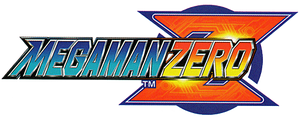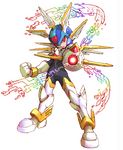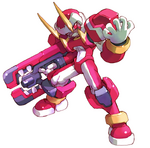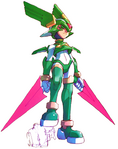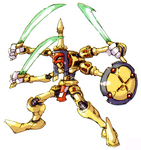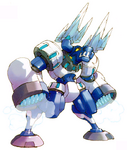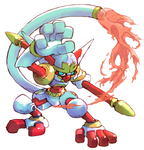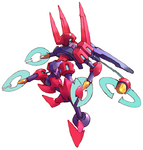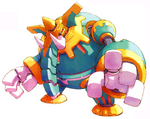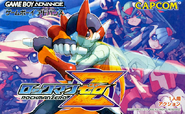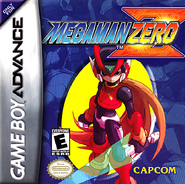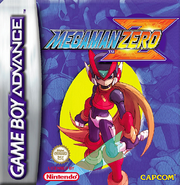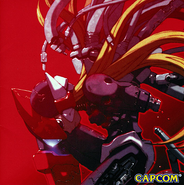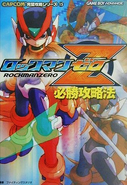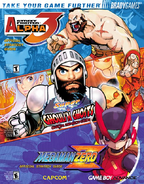(Sorry, those automated pics you have to click when adding ref links were not working earlier so I wanted to check things out.) |
(Work in progress.) Tag: Visual edit |
||
| Line 1: | Line 1: | ||
[[Image:MegaManZeroLogo.png|center|300px]] |
[[Image:MegaManZeroLogo.png|center|300px]] |
||
| + | '''Mega Man Zero''', known in Japan as {{nihongo|'''Rockman Zero'''|ロックマン ゼロ}}, is a video game developed by [[Inti Creates]] and published by [[Capcom]] for the Game Boy Advance (GBA). It is the first installment in the ''[[Mega Man Zero (series)|Mega Man Zero]]'' series, the fifth sub-series in Capcom's ''[[Mega Man (series)|Mega Man]]'' video game franchise. It was released in Japan on April 26, 2002, and in North America and Europe later that year. |
||
| − | '''Mega Man Zero''', produced by [[Keiji Inafune]], is the first of four games in the ''[[Mega Man Zero Series|Mega Man Zero]]'' series. |
||
| + | |||
| + | The game is set 100 years following the ''[[Mega Man X (series)|Mega Man X]]'' saga and follows the Reploid protagonist [[Zero]], who is awakened from a century of sleep to aid a human scientist named Ciel and her resistance force in a fight against the utopia of Neo Arcadia, which is attempting to unjustly wipe out all androids it views as threats. Like its predecessors in the [[Mega Man (original series)|original ''Mega Man'']] series and ''Mega Man X'' series, ''Mega Man Zero'' is an action-platformer game. However, the game forgoes the franchise's traditional format of letting the player select stages and acquire each boss's weapon. It instead features a smaller number of upgradable weapons and mission-based progression within a large, interconnected world. The player may also acquire special power-ups called "Cyber Elves" which supplement the player's abilities or add various effects to a mission's stage. |
||
| + | |||
| + | ''Mega Man Zero'' was produced as a commission product by Inti Creates for Capcom. The developer was responsible for all aspects of the game except the inclusion of the protagonist Zero, which was requested by series producer [[Keiji Inafune]]. ''Mega Man Zero'' has enjoyed a mostly positive press reception. Critics lauded the game's storyline, graphics, and tweaks on the franchise's classic action formula, though many were put off by aspects of its extreme difficulty level. ''Mega Man Zero'' garnered strong sales upon its debut and went on to produce three direct sequels on the GBA, as well as two titles in a sequel series on the Nintendo DS. It was released on the Wii U's Virtual Console in Japan on October 22, 2014.<ref>{{cite web|title=Virtual Console update: GBA titles, Breath of Fire and more|url=http://www.capcom-unity.com/brelston/blog/2014/06/09/virtual-console-update-gba-titles-breath-of-fire-and-more|date=June 9, 2014}}</ref> |
||
The game was re-released in 2010 as part of the compilation game, ''Mega Man Zero Collection'' for the Nintendo DS. |
The game was re-released in 2010 as part of the compilation game, ''Mega Man Zero Collection'' for the Nintendo DS. |
||
| + | |||
| ⚫ | |||
| + | ''Mega Man Zero'' adopts the [[action game|action]]-[[platform game|platforming]] gameplay prescribed by its predecessors in the [[Mega Man (original series)|original ''Mega Man'']] and ''[[Mega Man X]]'' series. The player, as the protagonist Zero, is tasked with completing several [[side-scrolling video game|side-scrolling]] stages, destroying enemies, completing objectives and battling [[boss (video gaming)|bosses]]. The player can run, jump, fire the player character's primary weapon, or use a secondary weapon if it is available. As in the ''Mega Man X'' games, the player can dash along the ground, cling to and scale walls, or perform a combination of these abilities.<ref name="ignreview" /><ref name="zero1manual" /> Unlike previous titles in the franchise where separate stages are selectable from a menu, ''Mega Man Zero'' is presented as a single, interconnected overworld. The Resistance base acts as a hub with almost every area in the game freely explorable from it. The player is given a choice of missions to undertake for each section of the map.<ref name="zero1manual" /> Completing one mission may unlock others. The player has only three lives to successfully complete a mission before receiving a [[game over]]. However, it is possible to fail non-critical missions by escaping the stage, using up both [[Continue (video gaming)|continues]], or giving up the mission after dying. Doing so marks the mission as a failure, making it unavailable for the game's remainder.<ref name="ignreview" /><ref name="gamespyreview" /> |
||
| + | |||
| + | When available, each of the player's four weapons can be charged up for a more powerful attack. Moreover, the player can [[Experience point|level-up]] weapons with prolonged use of them.<ref name="gamespotreview" /> Depending on the weapon, leveling one up will allow for more attacks, increased attack range, or shortened charge time. In previous ''Mega Man'' games, the player would obtain new weapons from defeated bosses and could in turn use those weapons against other bosses and minor enemies. In ''Mega Man Zero'', defeating some bosses earns the player elemental chips (thunder, fire, or ice) that can be used during a charged attack to further damage foes weak to a specific element.<ref name="cvg">{{cite web|author=Davies, Paul|year= 2002|title=''Mega Man Zero'' Review|url= http://www.computerandvideogames.com/80115/reviews/mega-man-zero-review/|publisher=[[Future plc]]|work=[[Computer and Video Games]]|accessdate=January 25, 2012}}</ref><ref name="official">{{cite web|author=Capcom staff|script-title=ja:ゲーム概要|trans-title=Gameplay Overview|url=http://www.capcom.co.jp/rockmanzero1/game.html|publisher=[[Capcom]]|language=Japanese|accessdate=February 13, 2012|deadurl=yes|archiveurl=https://web.archive.org/web/20121208041515/http://www.capcom.co.jp/rockmanzero1/game.html|archivedate=December 8, 2012|df=}}</ref> ''Mega Man Zero'' also introduces "Cyber Elves", which can be found hidden in certain missions or dropped by enemies. Cyber Elves are collectible, single-use aids with either temporary or permanent effects on Zero or the game's levels.<ref name="ignreview" /><ref name="zero1manual" /> Cyber Elf effects range widely, from reducing the life gauge of a boss to slowing down all enemies in a stage.<ref name="gamespotreview" /><ref name="completeworks">{{cite book|isbn=978-1-897376-01-0|date=June 10, 2008|title=Mega Man Zero: Official Complete Works|publisher=[[UDON|Udon Entertainment]]|pages=168–74}}</ref> Up to three Cyber Elves can be equipped for a given level and some can only be activated once they are fed sufficient energy crystals picked up or collected from defeated enemies.<ref name="ignreview" /><ref name="gamespyreview" /><ref name="official" /> The player's performance is scored on a percentage scale and graded at the end of each mission. The results are based on parameters including the completion time, the number of enemies destroyed, and the player's total damage.<ref name="official" /> |
||
| + | |||
| + | ==Plot== |
||
| + | The narrative of ''Mega Man Zero'' is presented through text dialogue cutscenes with [[2D computer graphics|2D]] sprites and hand-drawn, [[anime]] images.<ref name="ignreview">{{cite web|title=''Mega Man Zero'' Review|url=http://gameboy.ign.com/articles/371/371895p1.html| author=Harris, Craig|publisher=[[IGN]]|date=September 23, 2002|accessdate=August 25, 2006}}</ref><ref name="gamespyreview">{{cite web|title=''Mega Man Zero'' Review|url=http://archive.gamespy.com/reviews/november02/megamanzerogba/|author=Fryman, Avi|work=[[GameSpy]]|publisher=[[IGN|IGN Entertainment]]|date=November 1, 2002|accessdate=August 25, 2006|deadurl=yes|archiveurl=https://web.archive.org/web/20060820032504/http://archive.gamespy.com/reviews/november02/megamanzerogba/|archivedate=August 20, 2006|df=}}</ref> The storyline takes place about a century after the events of the ''[[Mega Man X]]'' saga of games. This earlier series entails a world inhabited by intelligent, self-aware [[Android (robot)|androids]] called "Reploids" and their struggle to coexist with their human creators. After stopping the efforts of the evil "Maverick" leader [[List of Mega Man X characters#Sigma|Sigma]] from wiping out humanity, the heroic Maverick Hunters [[List of Mega Man X characters#Mega Man X|Mega Man X]] and [[Zero (Mega Man)|Zero]] have long since vanished.<ref name="gamespotreview">{{cite web|title=Review: ''Mega Man Zero''|url= http://www.gamespot.com/gba/action/megamanzero/review.html|author=Tracy, Tim|work=[[GameSpot]] |publisher=[[CBS Interactive]]|date= October 1, 2002|accessdate=August 25, 2006}}</ref> The story of ''Mega Man Zero'' begins with a human scientist named Ciel and her Reploid companions being chased through an underground lab. Their relentless pursuers are mass-produced androids called Pantheons, among other terrible machines. After heavy losses, Ciel and the remaining resistance troops arrive at a sealed chamber containing Zero, who has been powered down for 100 years.<ref name="ignreview" /><ref name="zero1manual">{{cite book|editor=Capcom|title=Mega Man Zero ''Instruction Booklet''|date=September 10, 2002|publisher=[[Capcom|Capcom Entertainment, Inc.]]|pages=2–18|id=AGB-AZCE-USA}}</ref> Zero is awakened from his century-long slumber to a world where Reploids are constantly accused of being Mavericks and systematically "[[murder|retired]]", apparently under the direction of the once-famed Mega Man X.<ref>{{cite video game|title=Mega Man Zero|developer=Capcom|publisher=[[Capcom]]|date=September 10, 2002|platform=Game Boy Advance|quote='''Ciel:''' X... That legendary Reploid is still alive and he's trying to retire all of us. '''Zero:''' X is trying to... retire you...? '''Ciel:''' His plans have already begun. Many innocent Reploids are being retired as we speak... We need your help. Our future depends on you... Please help us...}}</ref> Shocked at this revelation and filled with doubt about his own identity as the Maverick Hunter of legend, Zero joins the resistance and begins his fight against his former ally X and his [[utopia]] known as Neo Arcadia.<ref name="megamess">{{cite web|author=Parish, Jeremy|date=May 17, 2007|title=Mega Mess: ''Mega Man''<nowiki>'</nowiki>s Messy Story|url=http://www.1up.com/do/feature?pager.offset=2&cId=3159550|work=[[1UP.com]]|publisher=[[Ziff Davis]]|accessdate=December 4, 2011|deadurl=yes|archiveurl=https://web.archive.org/web/20121013091645/http://www.1up.com/do/feature?pager.offset=2&cId=3159550|archivedate=October 13, 2012|df=}}</ref> |
||
| + | |||
| + | Eventually, Zero discovers that the X that is controlling Neo Arcadia is actually a replication of the original. Ciel constructed "Copy X" because the real X disappeared a long time ago and a new leader was needed for Neo Arcadia.<ref>{{cite video game|title=Mega Man Zero|developer=Capcom|publisher=[[Capcom]]|date=September 10, 2002|platform=Game Boy Advance|quote='''Ciel:''' The world has become out of control. It's all because of Neo Arcadia... Extreme justice, where peace is maintained by force. Reploids were sacrificed for the happiness of humans. It was I who created Neo Arcadia... And it was I who regenerated X... It was I... '''Zero:''' What? What do you mean "regenerated"...? You resurrected X like you resurrected me? '''Ciel:''' No. It's different... You are an original, meaning that you are exactly like what you used to be... But X is...}}</ref> Copy X strived for X's ultimate desire for a peaceful world, but lacked the original's moral judgement.<ref name="megamess" /> Believing that the Reploid race as a whole posed a danger to humans, Copy X began [[genocide|an operation]] to brand any Reploid whom he believed to be a menace to humanity as a Maverick and annihilate them without fair trial.<ref>{{cite video game|title=Mega Man Zero|developer=Capcom|publisher=[[Capcom]]|date=September 10, 2002|platform=Game Boy Advance|quote='''Zero:''' You... You must be the pirate copy of X... '''Copy X:''' No... A perfect copy of the original X. The new hero who saved the human race from this wasted world. Didn't you notice...? The humans have found happiness more than ever before... The utopia that humans have searched for, is here in Neo Arcadia. This is something that you and the original X could never create... Only I could do this!}}</ref> Zero reaches Copy X after battling his way through Neo Arcadia's Four Guardians. Copy X is defeated, then [[self-destruct]]s in order to ensure Zero's demise. Zero escapes just in time from Neo Arcadia as Copy X, and everything around him, is destroyed. Running low on energy, Zero faints in a desert close to Neo Arcadia. A mysterious voice is heard and reveals itself as the true X, who has been Zero's guide the entire time. X explains that he grew tired of fighting and, without a physical body, he has left Zero the responsibility of bringing peace to the world.<ref>{{cite video game|title=Mega Man Zero|developer=Capcom|publisher=[[Capcom]]|date=September 10, 2002|platform=Game Boy Advance|quote='''X:''' Since you disappeared I've been fighting this war alone against an uncountable number of Mavericks for nearly a hundred years... Battle after battle... So painful and so sad... But the hardest part was when I discovered that I no longer cared about fighting enemies... I'll leave this world to you... Please allow me... to rest in peace... for a while... ......... I'm sorry, Zero.}}</ref> Just as X vanishes, Zero finds himself surrounded by an army of Pantheons. Zero accepts X's words and promises to continue the fight against Neo Arcadia. The final scene shows Zero as he dashes into battle against the Pantheons and slices one in half. |
||
| + | |||
| + | ==Development== |
||
| + | ''Mega Man Zero'' was developed by [[Inti Creates]], a company established in 1996 by several former members of the game's publisher [[Capcom]].<ref>{{cite web|author=Jeriaska |date=October 4, 2008 |title=''Mega Man 9'' music interview with Inti Creates’ Ippo Yamada |url=http://www.siliconera.com/2008/10/04/mega-man-9-music-interview-with-inti-creates-ippo-yamada/ |publisher=Siliconera |accessdate=March 25, 2011 |deadurl=yes |archiveurl=https://web.archive.org/web/20110716071526/http://www.siliconera.com/2008/10/04/mega-man-9-music-interview-with-inti-creates-ippo-yamada/ |archivedate=July 16, 2011 }}</ref> Prior to the game's conception, Capcom had developed numerous games in its ''Mega Man'' franchise beginning with its classic series in 1987, then expanding to its ''Mega Man X'' spin-off series and two non-platformer series, ''[[Mega Man Legends]]'' and ''[[Mega Man Battle Network]]''.<ref name="playmag">{{cite magazine |magazine=[[Play (UK magazine)|Play]]|date=April 2004|author=Hoffman, Chris|title=The Best Damn ''Mega Man'' Feature Period|volume=3|issue=4|publisher=[[Imagine Publishing]]|issn=1747-7859}}</ref> Up until the development of ''Mega Man Zero'', Inti Creates was not a successful venture.<ref name="edge">{{cite web|author=Edge staff|date=August 22, 2005|title=No More ''Mega Man''?|url=http://www.next-gen.biz/news/no-more-mega-man|work=[[Edge (magazine)|Edge]]|publisher=[[Future plc]]|accessdate=March 25, 2011|deadurl=yes|archiveurl=https://web.archive.org/web/20110412071355/http://www.next-gen.biz/news/no-more-mega-man|archivedate=April 12, 2011|df=}}</ref> The company's vice president Yoshihisa Tsuda had wanted to create a ''Mega Man'' game and would often attend game conventions to express this interest to [[Keiji Inafune]], an artist and producer for the franchise. Inafune eventually called Inti Creates requesting a game proposal, on which the company promptly began working.<ref name="completeworks" /> ''Mega Man Zero'' was developed as a [[Commission (remuneration)|commission]] product by Inti Creates, who were given a free rein on its design and premise.<ref name="edge" /> The game was [[Video game producer|produced]] by Inti Creates president Takuya Aiza and was co-directed by Ryota Ito and Capcom's Yoshinori Kawano.<ref name="completeworks" /> Inafune signed on as the game's co-producer.<ref>{{cite magazine| title=Power Profiles: Keiji Inafune|date=October 2007|magazine=[[Nintendo Power]]|author= ''Nintendo Power'' staff|publisher=[[Nintendo|Nintendo of America]]|issue=220|pages=79–81| issn=1041-9551}}</ref> |
||
| + | |||
| + | One goal for the developer was to make ''Mega Man Zero'' the most challenging out of all the games in the franchise up to that point. The gameplay model and characters act as extensions of the ''Mega Man X'' series, which itself expands upon the original ''Mega Man'' series.<ref name="zxinterview">{{cite web|author=Bozon, Mark|date=September 8, 2006|title=''Mega Man ZX'' Interview|url=http://ds.ign.com/articles/731/731868p1.html|publisher=[[IGN]]|accessdate=March 25, 2011}}</ref> Zero was a secondary protagonist in the ''Mega Man X'' storyline. However, Inti Creates started developing ''Mega Man Zero'' without the character as the game's focus.<ref name="completeworks" /> Inafune had originally intended for 2000's ''[[Mega Man X5]]'' to be the final game in its own series, ending with Zero's death.<ref name="playmag" /><ref name="r20">{{cite book| isbn=978-1-897376-80-5|date=January 6, 2010|title=Mega Man X: Official Complete Works|publisher=[[UDON|Udon Entertainment]]|page=48}}</ref> When Inafune requested that they make Zero its central character, the company complied and inserted Zero into their draft.<ref name="completeworks" /> Though Zero was mostly depicted as a benevolent hero in the ''X'' series, the designers wanted to blur the line between good and evil when drawing up the new game's narrative. This meant having Zero and Ciel's resistance feared by humanity as terrorists and making the Four Guardians and Pantheons protectors of the human race.<ref name="completeworks" /> The game's main antagonist was a popular topic of discussion during production, and the developer often sought input from Capcom in this regard. Tsuda jokingly suggested that they make the original Mega Man X the final boss, an idea that was at first accepted. According to Ito, Inti Creates realized that it "wouldn't sit so well with the young boys and girls that really do see <nowiki>[X]</nowiki> as a hero", so they replaced him with Copy X just one month before release.<ref name="completeworks" /> It was around this time that the writers designated Ciel as Copy X's creator. Complex explanations were added to the timeline to make this consistent with Ciel's young age.<ref name="completeworks" /> Other parts of the storyline were adjusted towards the end of production to allow for a sequel, as the team felt the characters were "quite memorable in their own right".<ref name="completeworks" /> |
||
| + | |||
| + | The game's characters were designed by Toru Nakayama, while the graphics, concept art, and backgrounds were designed and illustrated by Azuma Honda. Based on Tsuda's ideas, the artists wanted to bridge the franchise's timeline gap between the "mechanical feel" of the ''X'' series and the "more human direction" of the ''Legends'' series.<ref name="completeworks" /> Inti Creates presented their concept art to Inafune and other members of Capcom at the [[Tokyo Game Show]]. Many of the designs were refined at this meeting and, as Nakayama explained, "a lot of trial-and-error ensued".<ref name="completeworks" /> First, Inafune wanted the artists to retain as much of the original Zero as possible, though the character's design was altered so consumers would not confuse the two series. Next, as Nakayama found it difficult to design the Cyber Elves, they were represented as simple balls of light or incomplete portraits within the game. Finally, because the game's Four Guardians had similar body structures and were each initially colored blue like X, Nakayama was forced to color them all differently, so as to make it easier to tell them apart as GBA [[Sprite (computer graphics)|sprites]].<ref name="completeworks" /> [[Ippo Yamada]] composed all but one track of the musical score for ''Mega Man Zero''; this remaining track, "Theme of Zero" from ''[[Mega Man X (video game)|Mega Man X]]'', was composed by Setsuo Yamamoto.<ref name="remastered">{{cite web|author=Square Enix Music Online staff| title=''Rockman Zero Remastered Tracks''|url= http://www.squareenixmusic.com/albums/r/rockmanzeroremaster.shtml|publisher=Square Enix Music Online|accessdate=January 3, 2012}}</ref> Yamada wanted to differentiate the style of music of the ''Mega Man Zero'' series from this predecessor by treating it "more like a television or film-like presentation than the stage system like before".<ref name="yamada">{{cite web| author=Greening, Chris|date=May 2010|title=Interview with Ippo Yamada, Ryo Kawakami, and Hiroki Isogai|url=http://www.squareenixmusic.com/features/interviews/ippoyamada.shtml|publisher= Square Enix Music Online|accessdate=January 3, 2012}}</ref> |
||
| + | |||
| + | ''Mega Man Zero'' was first announced by Capcom on January 22, 2002 at a press event in [[Las Vegas, Nevada|Las Vegas]].<ref name="gbstuff">{{cite web|title=Game Boy Stuff from Capcom|url= http://gameboy.ign.com/articles/101/101128p1.html|author=IGN staff|publisher=[[IGN]]|date= January 22, 2002|accessdate=January 5, 2007}}</ref> A copy of the game appeared at the 15th Next Generation World Hobby Fair in Japan on the following week on January 28.<ref name="gamespotpreview">{{cite web|title=Hands-on ''Mega Man Zero''|url= http://www.gamespot.com/mega-man-zero/previews/hands-onmega-man-zero-2843203/|author=Yukiyoshi Ike Sato| publisher=[[CBS Interactive]]|work=[[GameSpot]]|date=January 28, 2002|accessdate= January 5, 2007}}</ref> ''Mega Man Zero'' was officially released in Japan on April 26, 2002.<ref name="jprelease" /> The game appeared at the [[Electronic Entertainment Expo]] show that May in preparation for its North American release.<ref name="ignimages">{{cite web|title=E3 2002: ''Mega Man Zero'' Update|url=http://gameboy.ign.com/articles/360/360170p1.html|author= Harris, Craig|publisher=[[IGN]]|date= May 20, 2002|accessdate=January 5, 2007}}</ref> ''Mega Man Zero'' arrived in stores stateside as early as September 10, 2002.<ref name="narelease" /> Nintendo announced the game for a December 2002 release in Europe, but it was moved up to October 31 of that year.<ref name="eurelease" /><ref>{{cite web|author=Yeung, Karlie|date=May 22, 2002|title=Release Schedule for Europe|url=http://www.nintendoworldreport.com/news/7418| publisher=Nintendo World Report|accessdate=January 14, 2012}}</ref> The game's depictions of violence, specifically the amount of blood, were toned down for its Western localizations.<ref>{{cite web|author=Gonzalez, Joveth|date=May 10, 2010|title=''Mega Man Zero'' Recollections: The ''Mega Man'' Network|url=http://www.capcom-unity.com/jgonzo/blog/2010/05/10/mega_man_zero_recollections:_the_mega_man_network|work=Capcom Unity|publisher=[[Capcom]]|accessdate=January 16, 2012}}</ref> |
||
| + | |||
| + | |||
== Characters == |
== Characters == |
||
[[Image:MMZJapanArt.png|435px|right|thumb|''Japanese Cover Art'']] |
[[Image:MMZJapanArt.png|435px|right|thumb|''Japanese Cover Art'']] |
||
| Line 42: | Line 67: | ||
* '''[[Yellow Devil#Variations|Rainbow Devil]]''' |
* '''[[Yellow Devil#Variations|Rainbow Devil]]''' |
||
| − | == |
+ | ==Reception== |
| + | ==Reception and legacy== |
||
| − | The year is AD 22XX. The [[Sigma]] Virus, a malevolent virus which drove the Reploids berserk and instigated the costly Maverick Wars, has been stopped by Mega Man X. After the wars were over, the people of Earth began to rebuild the planet. |
||
| + | {{Video game reviews |
||
| + | | GR = 81%<ref name="gamerankings">{{cite web|title=''Mega Man Zero'' for Game Boy Advance|url= http://www.gamerankings.com/gba/551912-mega-man-zero/index.html|work=[[GameRankings]]| publisher=[[CBS Interactive]]|accessdate=June 25, 2010}}</ref> |
||
| + | | MC = 82/100<ref name="metacriticreview">{{cite web|url= http://www.metacritic.com/game/game-boy-advance/mega-man-zero|title=''Mega Man Zero'' for Game Boy Advance|work=[[Metacritic]]|publisher=[[CBS Interactive]]|accessdate=January 15, 2012}}</ref> |
||
| + | | CVG = 8/10<ref name="cvg"/> |
||
| + | | EGM = 8/10<ref>{{cite magazine|magazine=[[Electronic Gaming Monthly]]|publisher=[[Ziff Davis]]|title=Review Crew: ''Mega Man Zero''|issue=159|author=''Electronic Gaming Monthly'' staff|date=September 2002|page=162|issn=1058-918X}}</ref> |
||
| + | | Fam = 26/40<ref>{{cite web|author=Rodriguez, Steven|date=April 23, 2002|title=Weekly ''Famitsu'' GBA Scores|url=http://www.nintendoworldreport.com/newsArt.cfm?artid=7262| publisher=Nintendo World Report|accessdate=June 23, 2010}}</ref> |
||
| + | | GI = 8.3/10<ref>{{cite magazine|magazine=[[Game Informer]]|publisher=Sunrise Publications| title=Reviews: ''Mega Man Zero''|author=Game Informer staff|date=August 2002|issue=112|page=90|issn=1067-6392}}</ref> |
||
| + | | GamePro = {{rating|3.5|5}}<ref>{{cite web|author=Star Dingo|date=September 10, 2002|title= ''Mega Man Zero'' Review|url=http://www.gamepro.com/article/reviews/26149/mega-man-zero/|work=[[GamePro]]|publisher=[[International Data Group|IDG]]|accessdate=June 25, 2010|archiveurl= https://web.archive.org/web/20091110141726/http://www.gamepro.com/article/reviews/26149/mega-man-zero/|archivedate=November 10, 2009}}</ref> |
||
| + | | GSpot = 8.2/10<ref name="gamespotreview"/> |
||
| + | | GSpy = 85/100<ref name="gamespyreview" /> |
||
| + | | GameZone = 9.1/10<ref name="gamezonereview">{{cite web|url= http://gameboy.gamezone.com/gzreviews/r19802_GBA.htm|archiveurl= https://web.archive.org/web/20021019004931/http://gameboy.gamezone.com/gzreviews/r19802_GBA.htm| title=''Mega Man Zero'' Review|author=McElfish, Carlos|publisher=GameZone|date=October 1, 2002|archivedate=October 19, 2002 |accessdate=January 26, 2007}}</ref> |
||
| + | | IGN = 8.8/10<ref name="ignreview" /> |
||
| + | | NP = 8.4/10<ref>{{cite magazine|magazine=[[Nintendo Power]]|publisher=[[Nintendo|Nintendo of America]]|title=Now Playing: ''Mega Man Zero''|author=Nintendo Power staff|date=September 2002|issue=160|page=165|issn=1041-9551}}</ref> |
||
| + | }} |
||
| + | ''Mega Man Zero'' has met with a mostly positive critical reception, holding scores of 81% and 82 out of 100 respectively on the aggregate review sites [[GameRankings]] and [[Metacritic]].<ref name="gamerankings" /><ref name="metacriticreview" /> |
||
| + | Reviewers across the board agreed that the game was the most difficult in the series,<ref name="gamespyreview" /><ref name="metacriticreview" /><ref name="gamezonereview" /> with one reviewer suggesting that it is not for younger or casual players.<ref name="gamespotreview" /> Avi Fryman of GameSpy.com states that the ability to give up on missions and still continue the game is a sensible feature of ''Mega Man Zero'',<ref name="gamespyreview" /> whereas IGN states that given the difficulty of the game, no one would call a player "cheap" if they were to use the newly introduced Cyber Elf system to make boss fights easier.<ref name="ignreview" /> Overall, the Cyber Elf System earned a lukewarm response, though many did acknowledge that it made an otherwise difficult game easier.<ref name="ignreview" /><ref name="gamespyreview" /> |
||
| − | Neo Arcadia was established by X as a paradise for the humans, a place where Reploids and humans could live in peace. However, the governing council soon became overcome with paranoia about Reploids turning Maverick, and thus began persecuting them mercilessly. |
||
| + | Common complaints with the game were slow down,<ref name="gamezonereview" /> "unseen deathtraps"<ref name="gamespyreview" /> and being required to make blind jumps.<ref name="ignreview" /> These, however, did not seem to detract much from the gaming experience as reviewers tended to recommend the game in their conclusions.<ref name="metacriticreview" /> |
||
| − | Ciel is a Reploid Researcher who has been searching for a substitute energy to help ease an ongoing energy crisis. Seeing the mistreatment of Reploids, she fled with a group of them to an abandoned city. She has been searching for Zero, who fought with X during the Maverick Wars over 100 years prior. As she and the Reploids are chased by the army of Neo Arcadia, she moves deeper into the forgotten city, searching for the legendary Reploid, for she believes Zero is their only hope against the government. |
||
| + | |||
| + | Capcom reported healthy sales of ''Mega Man Zero'' during its release period.<ref>{{cite web|author=Capcom staff|publisher=[[Capcom]]|year=2002|title=Annual Report 2001|format=PDF|url=http://www.capcom.co.jp/ir/data/pdf/Annual2001.pdf#6|accessdate=February 9, 2012}}{{dead link|date=January 2018 |bot=InternetArchiveBot |fix-attempted=yes }}</ref><ref>{{cite web|author=Capcom staff|publisher=[[Capcom]]|year=2003|title=Annual Report 2002|format=PDF|url=http://www.capcom.co.jp/ir/data/pdf/Annual2003.pdf#10|accessdate=February 9, 2012}}{{dead link|date=January 2018 |bot=InternetArchiveBot |fix-attempted=yes }}</ref> It was the third best-selling video game in Japan during its week of release at 66,990 units.<ref>{{cite web|author=IGN Staff|date=May 3, 2002|title=The ''Famitsu'' Top 10 (04/22/02 - 04/28/02)|url=http://ps2.ign.com/articles/358/358478p1.html|publisher=[[IGN]]|accessdate= June 23, 2010}}</ref> ''[[Famitsu]]'' sales data supports that ''Mega Man Zero'' sold 135,850 units by June 2002 and 231,166 units by the end of that year in Japan alone.<ref>{{cite web| author=Yoshinoya, Bakudan|date=June 1, 2002|title=''Famitsu'' Top 30|url= http://www.nintendoworldreport.com/newsArt.cfm?artid=7440|publisher=Nintendo World Report| accessdate=June 23, 2010}}</ref><ref>{{cite web|title=2002年テレビゲームソフト売り上げTOP300|trans-title=2002 Video Game Software Sales Top 300|url= http://geimin.net/da/db/2002_ne_fa/index.php|publisher=Geimin.net|language=Japanese| accessdate=June 23, 2010}}</ref> The popularity of ''Mega Man Zero'' spawned three direct sequels on the GBA.<ref name="gamesradar">{{cite web|author=Elston, Brett|date=June 30, 2008| title=The ultimate ''Mega Man'' retrospective|url=http://www.gamesradar.com/the-ultimate-mega-man-retrospective/?page=7|work=[[GamesRadar]]|publisher=[[Future plc]]|accessdate=December 26, 2010}}</ref> |
||
| + | <ref name="collection">{{cite web|author=Thomas, Lucas M.|date=July 8, 2010|title=''Mega Man Zero Collection'' Review|url=http://ds.ign.com/articles/110/1104681p1.html|publisher=[[IGN]]| accessdate=January 5, 2012}}</ref> These games were developed by the same, core team members as the first ''Mega Man Zero'' title.<ref name="completeworks" /><ref name="yamada" /> Beginning in 2006, Inti Creates began releasing follow-up series on the [[Nintendo DS]] comprising two games: ''[[Mega Man ZX]]'' and ''[[Mega Man ZX Advent]]''.<ref name="gamesradar" /><ref>{{cite web|author=Parish, Jeremy|date=February 14, 2011|title=Departing Salute - The Best of DS #14: ''Mega Man ZX Advent''|url=http://www.1up.com/news/departing-salute-14-mega-man|work=[[1UP.com]]|publisher=[[Ziff Davis]]|accessdate=January 9, 2012|deadurl=yes|archiveurl=https://web.archive.org/web/20130319112807/http://www.1up.com/news/departing-salute-14-mega-man|archivedate=March 19, 2013|df=}}</ref> In 2010, all four ''Mega Man Zero'' games were included in the ''Mega Man Zero Collection'', released worldwide on the DS. This compilation removes all references to death and dying, features an easy difficulty mode, and makes other, minor alterations to all four games.<ref name="collection" /> |
||
| + | |||
| + | In addition to games, other media related to ''Mega Man Zero'' exists. A [[manga]] based on the series was written and illustrated by Hideto Kajima and serialized in the monthly [[Shogakukan]] magazine ''[[CoroCoro Comic]]'' from June 2003 to February 2006.<ref>{{cite web|author=Houck, Janet|date=April 11, 2007|title=Blue Bombing the Manga Scene|url=http://www.mania.com/blue-bombing-manga-scene_article_54303.html|publisher=Mania.com|accessdate=February 21, 2012|deadurl=yes|archiveurl=https://web.archive.org/web/20090912042209/http://www.mania.com/blue-bombing-manga-scene_article_54303.html|archivedate=September 12, 2009|df=}}</ref><ref>{{cite journal|author=Hideto, Kajima|journal=[[CoroCoro Comic|CoroCoro Comic Special]]|series=''Rockman Zero''|issue=June 2003 issue|script-title=ja:目覚めたヒーロー!!|trans-title=The Hero Awakens!!|date=April 30, 2003|publisher=[[Shogakukan]]|language=Japanese}}</ref><ref>{{cite journal|author=Hideto, Kajima|journal=[[CoroCoro Comic|CoroCoro Comic Special]]|series=''Rockman Zero''|issue=February 2006 issue|script-title=ja:クリスマスの大激闘!!|trans-title=Christmas' Great Battle!!|date=December 28, 2005|publisher=[[Shogakukan]]|language=Japanese}}</ref> Capcom did not immediately publish a soundtrack containing the score for ''Mega Man Zero''. Instead, composer Ippo Yamada directed the release of an [[Arrangement|arrange album]] containing remixed versions of the game's songs.<ref name="yamada" /> The album, ''[[Music of the Mega Man Zero series#Remastered Tracks Rockman Zero|Remastered Tracks Rockman Zero]]'', was released in Japan on January 23, 2004.<ref name="remastered" /> In addition to the 21 songs, this CD features five [[Radio drama in Japan|drama tracks]]; commentary tracks by Yamada; an interview with the Inti Creates sound team; character descriptions and an interview with character designer Toru Nakayama; and guest [[liner notes]] from artist and [[manga creator]] Hitoshi Ariga.<ref name="completeworks" /><ref name="yamada" /><ref>{{cite web|author=Inti Creates staff|title=''Remastered Tracks Rockman Zero''|url=http://www.inti.co.jp/cd/zero1/index.htm|publisher=[[Inti Creates]]|language= Japanese|accessdate=January 3, 2012}}</ref> The in-game instrumental music was compiled on the ''[[Music of the Mega Man Zero series#Rockman Zero Game Music Complete Works -Rockman Zero 1~3-|Rockman Zero Game Music Complete Works -Rockman Zero 1~3-]]'' soundtrack, released in Japan by [[Suleputer]] on July 1, 2004.<ref>{{cite web|author=Suleputer staff|script-title=ja:ロックマン ゼロ ゲーム音楽大全集 - ロックマン ゼロ 1~3 -|trans-title=''Rockman Zero Game Music Complete Works -Rockman Zero 1~3-''|url=http://suleputer.capcom.co.jp/product/cd/cpca1092.html|publisher=[[Suleputer]] |language=Japanese|accessdate=February 10, 2012}}</ref><ref>{{cite web|author=Square Enix Music Online|title=''Rockman Zero 1 ~ 3 Game Music Collection''|url=http://www.squareenixmusic.com/albums/r/rockmanzero1-3.shtml|publisher=Square Enix Music Online|accessdate=January 3, 2012|deadurl=yes|archiveurl=https://web.archive.org/web/20100115141942/http://squareenixmusic.com/albums/r/rockmanzero1-3.shtml|archivedate=January 15, 2010|df=}}</ref> An [[art book]] titled ''Mega Man Zero Official Complete Works'' was published in Japan by Capcom in 2006 and in North America by [[UDON|Udon Entertainment]] in 2008.<ref>{{cite web|author=Capcom staff|script-title=ja:ロックマンゼロ オフィシャルコンプリートワークス|trans-title=''Rockman Official Complete Works''|url=http://www.e-capcom.com/ec/srDispProductListProductLink/doProductLink/1/1/A10003528/10/10/srDispProductList/ |publisher=[[Capcom]]|language=Japanese|accessdate=February 22, 2012}}</ref><ref>{{cite web|author=Capcom staff|title=''Mega Man® Zero Official Complete Works'' (book)|url=http://shop.capcom.com/store/capcomus/en_US/pd/productID.104608300?resid=Tv-QigoBAlkAAE9LDjcAAAAd&rests=1329927150403|publisher=[[Capcom]]|accessdate=February 22, 2012|deadurl=yes|archiveurl=https://archive.is/20120715173808/http://shop.capcom.com/store/capcomus/en_US/pd/productID.104608300?resid=Tv-QigoBAlkAAE9LDjcAAAAd&rests=1329927150403|archivedate=July 15, 2012|df=}}</ref> The book contains detailed information on the series, promotional artwork, concept designs and sketches, and interviews with the Inti Creates staff.<ref>{{cite web|author=IGN staff|date=February 20, 2007|title=''Mega Man'' Art Headed to Stores|url= http://comics.ign.com/articles/766/766252p1.html|publisher=[[IGN]]|accessdate=February 21, 2012}}</ref> |
||
| ⚫ | |||
| − | {{Incomplete section}} |
||
== Gallery == |
== Gallery == |
||
| Line 87: | Line 130: | ||
Image:TripleStrategyGuide.PNG|''Strategy Guide'' |
Image:TripleStrategyGuide.PNG|''Strategy Guide'' |
||
</gallery> |
</gallery> |
||
| + | |||
| + | ==References== |
||
| + | <references /> |
||
== External Links == |
== External Links == |
||
Revision as of 19:16, 22 April 2018
Mega Man Zero, known in Japan as Rockman Zero (ロックマン ゼロ), is a video game developed by Inti Creates and published by Capcom for the Game Boy Advance (GBA). It is the first installment in the Mega Man Zero series, the fifth sub-series in Capcom's Mega Man video game franchise. It was released in Japan on April 26, 2002, and in North America and Europe later that year.
The game is set 100 years following the Mega Man X saga and follows the Reploid protagonist Zero, who is awakened from a century of sleep to aid a human scientist named Ciel and her resistance force in a fight against the utopia of Neo Arcadia, which is attempting to unjustly wipe out all androids it views as threats. Like its predecessors in the original Mega Man series and Mega Man X series, Mega Man Zero is an action-platformer game. However, the game forgoes the franchise's traditional format of letting the player select stages and acquire each boss's weapon. It instead features a smaller number of upgradable weapons and mission-based progression within a large, interconnected world. The player may also acquire special power-ups called "Cyber Elves" which supplement the player's abilities or add various effects to a mission's stage.
Mega Man Zero was produced as a commission product by Inti Creates for Capcom. The developer was responsible for all aspects of the game except the inclusion of the protagonist Zero, which was requested by series producer Keiji Inafune. Mega Man Zero has enjoyed a mostly positive press reception. Critics lauded the game's storyline, graphics, and tweaks on the franchise's classic action formula, though many were put off by aspects of its extreme difficulty level. Mega Man Zero garnered strong sales upon its debut and went on to produce three direct sequels on the GBA, as well as two titles in a sequel series on the Nintendo DS. It was released on the Wii U's Virtual Console in Japan on October 22, 2014.[1]
The game was re-released in 2010 as part of the compilation game, Mega Man Zero Collection for the Nintendo DS.
Gameplay
Mega Man Zero adopts the action-platforming gameplay prescribed by its predecessors in the original Mega Man and Mega Man X series. The player, as the protagonist Zero, is tasked with completing several side-scrolling stages, destroying enemies, completing objectives and battling bosses. The player can run, jump, fire the player character's primary weapon, or use a secondary weapon if it is available. As in the Mega Man X games, the player can dash along the ground, cling to and scale walls, or perform a combination of these abilities.[2][3] Unlike previous titles in the franchise where separate stages are selectable from a menu, Mega Man Zero is presented as a single, interconnected overworld. The Resistance base acts as a hub with almost every area in the game freely explorable from it. The player is given a choice of missions to undertake for each section of the map.[3] Completing one mission may unlock others. The player has only three lives to successfully complete a mission before receiving a game over. However, it is possible to fail non-critical missions by escaping the stage, using up both continues, or giving up the mission after dying. Doing so marks the mission as a failure, making it unavailable for the game's remainder.[2][4]
When available, each of the player's four weapons can be charged up for a more powerful attack. Moreover, the player can level-up weapons with prolonged use of them.[5] Depending on the weapon, leveling one up will allow for more attacks, increased attack range, or shortened charge time. In previous Mega Man games, the player would obtain new weapons from defeated bosses and could in turn use those weapons against other bosses and minor enemies. In Mega Man Zero, defeating some bosses earns the player elemental chips (thunder, fire, or ice) that can be used during a charged attack to further damage foes weak to a specific element.[6][7] Mega Man Zero also introduces "Cyber Elves", which can be found hidden in certain missions or dropped by enemies. Cyber Elves are collectible, single-use aids with either temporary or permanent effects on Zero or the game's levels.[2][3] Cyber Elf effects range widely, from reducing the life gauge of a boss to slowing down all enemies in a stage.[5][8] Up to three Cyber Elves can be equipped for a given level and some can only be activated once they are fed sufficient energy crystals picked up or collected from defeated enemies.[2][4][7] The player's performance is scored on a percentage scale and graded at the end of each mission. The results are based on parameters including the completion time, the number of enemies destroyed, and the player's total damage.[7]
Plot
The narrative of Mega Man Zero is presented through text dialogue cutscenes with 2D sprites and hand-drawn, anime images.[2][4] The storyline takes place about a century after the events of the Mega Man X saga of games. This earlier series entails a world inhabited by intelligent, self-aware androids called "Reploids" and their struggle to coexist with their human creators. After stopping the efforts of the evil "Maverick" leader Sigma from wiping out humanity, the heroic Maverick Hunters Mega Man X and Zero have long since vanished.[5] The story of Mega Man Zero begins with a human scientist named Ciel and her Reploid companions being chased through an underground lab. Their relentless pursuers are mass-produced androids called Pantheons, among other terrible machines. After heavy losses, Ciel and the remaining resistance troops arrive at a sealed chamber containing Zero, who has been powered down for 100 years.[2][3] Zero is awakened from his century-long slumber to a world where Reploids are constantly accused of being Mavericks and systematically "retired", apparently under the direction of the once-famed Mega Man X.[9] Shocked at this revelation and filled with doubt about his own identity as the Maverick Hunter of legend, Zero joins the resistance and begins his fight against his former ally X and his utopia known as Neo Arcadia.[10]
Eventually, Zero discovers that the X that is controlling Neo Arcadia is actually a replication of the original. Ciel constructed "Copy X" because the real X disappeared a long time ago and a new leader was needed for Neo Arcadia.[11] Copy X strived for X's ultimate desire for a peaceful world, but lacked the original's moral judgement.[10] Believing that the Reploid race as a whole posed a danger to humans, Copy X began an operation to brand any Reploid whom he believed to be a menace to humanity as a Maverick and annihilate them without fair trial.[12] Zero reaches Copy X after battling his way through Neo Arcadia's Four Guardians. Copy X is defeated, then self-destructs in order to ensure Zero's demise. Zero escapes just in time from Neo Arcadia as Copy X, and everything around him, is destroyed. Running low on energy, Zero faints in a desert close to Neo Arcadia. A mysterious voice is heard and reveals itself as the true X, who has been Zero's guide the entire time. X explains that he grew tired of fighting and, without a physical body, he has left Zero the responsibility of bringing peace to the world.[13] Just as X vanishes, Zero finds himself surrounded by an army of Pantheons. Zero accepts X's words and promises to continue the fight against Neo Arcadia. The final scene shows Zero as he dashes into battle against the Pantheons and slices one in half.
Development
Mega Man Zero was developed by Inti Creates, a company established in 1996 by several former members of the game's publisher Capcom.[14] Prior to the game's conception, Capcom had developed numerous games in its Mega Man franchise beginning with its classic series in 1987, then expanding to its Mega Man X spin-off series and two non-platformer series, Mega Man Legends and Mega Man Battle Network.[15] Up until the development of Mega Man Zero, Inti Creates was not a successful venture.[16] The company's vice president Yoshihisa Tsuda had wanted to create a Mega Man game and would often attend game conventions to express this interest to Keiji Inafune, an artist and producer for the franchise. Inafune eventually called Inti Creates requesting a game proposal, on which the company promptly began working.[8] Mega Man Zero was developed as a commission product by Inti Creates, who were given a free rein on its design and premise.[16] The game was produced by Inti Creates president Takuya Aiza and was co-directed by Ryota Ito and Capcom's Yoshinori Kawano.[8] Inafune signed on as the game's co-producer.[17]
One goal for the developer was to make Mega Man Zero the most challenging out of all the games in the franchise up to that point. The gameplay model and characters act as extensions of the Mega Man X series, which itself expands upon the original Mega Man series.[18] Zero was a secondary protagonist in the Mega Man X storyline. However, Inti Creates started developing Mega Man Zero without the character as the game's focus.[8] Inafune had originally intended for 2000's Mega Man X5 to be the final game in its own series, ending with Zero's death.[15][19] When Inafune requested that they make Zero its central character, the company complied and inserted Zero into their draft.[8] Though Zero was mostly depicted as a benevolent hero in the X series, the designers wanted to blur the line between good and evil when drawing up the new game's narrative. This meant having Zero and Ciel's resistance feared by humanity as terrorists and making the Four Guardians and Pantheons protectors of the human race.[8] The game's main antagonist was a popular topic of discussion during production, and the developer often sought input from Capcom in this regard. Tsuda jokingly suggested that they make the original Mega Man X the final boss, an idea that was at first accepted. According to Ito, Inti Creates realized that it "wouldn't sit so well with the young boys and girls that really do see [X] as a hero", so they replaced him with Copy X just one month before release.[8] It was around this time that the writers designated Ciel as Copy X's creator. Complex explanations were added to the timeline to make this consistent with Ciel's young age.[8] Other parts of the storyline were adjusted towards the end of production to allow for a sequel, as the team felt the characters were "quite memorable in their own right".[8]
The game's characters were designed by Toru Nakayama, while the graphics, concept art, and backgrounds were designed and illustrated by Azuma Honda. Based on Tsuda's ideas, the artists wanted to bridge the franchise's timeline gap between the "mechanical feel" of the X series and the "more human direction" of the Legends series.[8] Inti Creates presented their concept art to Inafune and other members of Capcom at the Tokyo Game Show. Many of the designs were refined at this meeting and, as Nakayama explained, "a lot of trial-and-error ensued".[8] First, Inafune wanted the artists to retain as much of the original Zero as possible, though the character's design was altered so consumers would not confuse the two series. Next, as Nakayama found it difficult to design the Cyber Elves, they were represented as simple balls of light or incomplete portraits within the game. Finally, because the game's Four Guardians had similar body structures and were each initially colored blue like X, Nakayama was forced to color them all differently, so as to make it easier to tell them apart as GBA sprites.[8] Ippo Yamada composed all but one track of the musical score for Mega Man Zero; this remaining track, "Theme of Zero" from Mega Man X, was composed by Setsuo Yamamoto.[20] Yamada wanted to differentiate the style of music of the Mega Man Zero series from this predecessor by treating it "more like a television or film-like presentation than the stage system like before".[21]
Mega Man Zero was first announced by Capcom on January 22, 2002 at a press event in Las Vegas.[22] A copy of the game appeared at the 15th Next Generation World Hobby Fair in Japan on the following week on January 28.[23] Mega Man Zero was officially released in Japan on April 26, 2002.[24] The game appeared at the Electronic Entertainment Expo show that May in preparation for its North American release.[25] Mega Man Zero arrived in stores stateside as early as September 10, 2002.[26] Nintendo announced the game for a December 2002 release in Europe, but it was moved up to October 31 of that year.[27][28] The game's depictions of violence, specifically the amount of blood, were toned down for its Western localizations.[29]
Characters
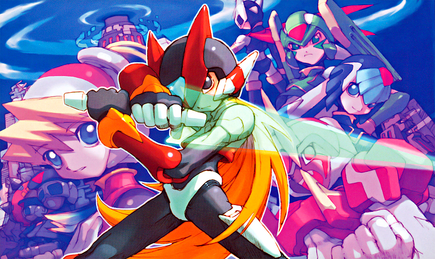
Japanese Cover Art
- Zero
- Ciel
- Alouette - is a child Reploid that treasures a doll Ciel gave her. She also looks up to, and admires, Ciel, with aspirations to follow in her footsteps as a researcher. She is an expert Cyber Elf handler and raises the Cyber Elves that Zero obtains.
- Cerveau - is the engineer who makes Zero's weapons; he also mentions that he works alongside Ciel in her research. He appears in all four Mega Man Zero games, where he creates parts and weapons to the player. He is constantly worrying about Ciel and Zero's safety. The player can also see the game database with him in Mega Man Zero 3 and 4.
- Pantheon - Pantheons are degraded, mass-produced Reploid copies of Mega Man X.
- Copy X - A Reploid based on Mega Man X's DNA, Copy X governed Neo Arcadia after X sacrificed his body to seal the Dark Elf. When faced with the energy shortage, he labeled innocent Reploids as Mavericks and, as the leader of Neo Arcadia, ordered his subordinates to begin destroying them with extreme prejudice. After his defeat, he is revived by Dr. Weil in Mega Man Zero 3 as Copy X MK-II.
- Fighting Fefnir - With two multi-type launchers, Sodom on his right arm and Gomra on his left, Fefnir leads Operation Scorched Earth. He is one of the Four Guardians designed to protect Copy X. Fefnir is constantly seeking worthy opponents to fight, and if it seems as though he's always picking a fight with Harpuia, it's only because he acknowledges his prowess in battle. Even in his battles with Zero, Fefnir's main concern is to get the most out of the experience.
- Sage Harpuia - The second of the Four Guardians, Harpuia is a Reploid with terra-forming capabilities used for aiding the humans in resettling the Earth after the destruction of the Maverick Wars. He must combine with his giant Mechaniloid to employ his full terra-forming abilities, but even on his own he is able to manipulate a weather orbit, allowing him to control the weather over a limited area.
- Fairy Leviathan - As a Reploid able to control currents and water temperature, Leviathan has paired up with Harpuia to execute large-scale projects aimed at helping humans re-populate habitable areas. She is the third of the Four Guardians. Though not particularly fond of violence, she seems to enjoy her battles with Zero for some reason. She is often found underwater, saying that "land is too dusty."
- Hidden Phantom - Leader of the anti-Resistance intelligence unit, the "Cutting Shadow Squadron." The other commanders do not think much of Phantom and his calm, quiet demeanor; but his loyalty to X is unwavering. Phantom feels no mercy for any who oppose X. Upon his defeat at Zero's hands, Phantom self-detonates in a desperate attempt to take Zero with him. Phantom, Copy X, Fefnir, Harpuia and Leviathan all appear in a series of mini-games in Mega Man Zero 3.
- Anubis Necromancess III - A member of Fefnir's Jin'en Army, Anubis attacks using his cane, summoning a pair of walls with spikes on top to smash Zero. He also summons Pantheon Zombies. A modified version of him, Anubis Necromancess V, appears in Mega Man Zero 3.
- Asura Basura - A boss encountered in the Neo Arcadia shrine, Asura is a four-armed Reploid that uses three swords and one shield.
- Blizzack Staggroff - An ice-based member of Leviathan's Meikai Army, he captures the Resistance Base and takes several hostages. He returns in Mega Man Zero 3 as Blizzack Staggroff R.
- Guard Orotic - An eight-headed Mechaniloid that shoots projectiles from its core.
- Hanumachine - A monkey-like Reploid, Hanumachine uses fire-based attacks. He can turn into a fireball and ricochet around the room Zero fights him in. He returns in Mega Man Zero 3 as Hanumachine R.
- Herculious Anchortus - Brother of Kuwagust Anchus, Herculious is a beetle-like Reploid encountered in the Neo Arcadia shrine.
- Hittite Hottide - Operated by a Pantheon, it is a giant digging Mechaniloid boss that was sent to attack the Resistance Base.
- Maha Ganeshariff - An elephant-like Mechaniloid, Maha rolls around like a ball while releasing bombs. He is also capable of swinging from the ceiling and throwing tusks.
- Pantheon Core - A Pantheon boss that is the core of a train, located in its engine chamber. It attacks with a flamethrower and tries to smash Zero into hidden spikes on the ceiling by lifting the floor.
- Rainbow Devil
Reception
Reception and legacy
Template:Video game reviews Mega Man Zero has met with a mostly positive critical reception, holding scores of 81% and 82 out of 100 respectively on the aggregate review sites GameRankings and Metacritic.[30][31]
Reviewers across the board agreed that the game was the most difficult in the series,[4][31][32] with one reviewer suggesting that it is not for younger or casual players.[5] Avi Fryman of GameSpy.com states that the ability to give up on missions and still continue the game is a sensible feature of Mega Man Zero,[4] whereas IGN states that given the difficulty of the game, no one would call a player "cheap" if they were to use the newly introduced Cyber Elf system to make boss fights easier.[2] Overall, the Cyber Elf System earned a lukewarm response, though many did acknowledge that it made an otherwise difficult game easier.[2][4]
Common complaints with the game were slow down,[32] "unseen deathtraps"[4] and being required to make blind jumps.[2] These, however, did not seem to detract much from the gaming experience as reviewers tended to recommend the game in their conclusions.[31]
Capcom reported healthy sales of Mega Man Zero during its release period.[33][34] It was the third best-selling video game in Japan during its week of release at 66,990 units.[35] Famitsu sales data supports that Mega Man Zero sold 135,850 units by June 2002 and 231,166 units by the end of that year in Japan alone.[36][37] The popularity of Mega Man Zero spawned three direct sequels on the GBA.[38] [39] These games were developed by the same, core team members as the first Mega Man Zero title.[8][21] Beginning in 2006, Inti Creates began releasing follow-up series on the Nintendo DS comprising two games: Mega Man ZX and Mega Man ZX Advent.[38][40] In 2010, all four Mega Man Zero games were included in the Mega Man Zero Collection, released worldwide on the DS. This compilation removes all references to death and dying, features an easy difficulty mode, and makes other, minor alterations to all four games.[39]
In addition to games, other media related to Mega Man Zero exists. A manga based on the series was written and illustrated by Hideto Kajima and serialized in the monthly Shogakukan magazine CoroCoro Comic from June 2003 to February 2006.[41][42][43] Capcom did not immediately publish a soundtrack containing the score for Mega Man Zero. Instead, composer Ippo Yamada directed the release of an arrange album containing remixed versions of the game's songs.[21] The album, Remastered Tracks Rockman Zero, was released in Japan on January 23, 2004.[20] In addition to the 21 songs, this CD features five drama tracks; commentary tracks by Yamada; an interview with the Inti Creates sound team; character descriptions and an interview with character designer Toru Nakayama; and guest liner notes from artist and manga creator Hitoshi Ariga.[8][21][44] The in-game instrumental music was compiled on the Rockman Zero Game Music Complete Works -Rockman Zero 1~3- soundtrack, released in Japan by Suleputer on July 1, 2004.[45][46] An art book titled Mega Man Zero Official Complete Works was published in Japan by Capcom in 2006 and in North America by Udon Entertainment in 2008.[47][48] The book contains detailed information on the series, promotional artwork, concept designs and sketches, and interviews with the Inti Creates staff.[49]
Gallery
Box Art
Merchandise
References
- ↑ Virtual Console update: GBA titles, Breath of Fire and more (June 9, 2014).
- ↑ 2.0 2.1 2.2 2.3 2.4 2.5 2.6 2.7 2.8 Harris, Craig (September 23, 2002). Mega Man Zero Review. IGN. Retrieved on August 25, 2006.
- ↑ 3.0 3.1 3.2 3.3 Template:Cite book
- ↑ 4.0 4.1 4.2 4.3 4.4 4.5 4.6 Fryman, Avi (November 1, 2002). Mega Man Zero Review. GameSpy. IGN Entertainment. Archived from the original on August 20, 2006. Retrieved on August 25, 2006.
- ↑ 5.0 5.1 5.2 5.3 Tracy, Tim (October 1, 2002). Review: Mega Man Zero. GameSpot. CBS Interactive. Retrieved on August 25, 2006.
- ↑ Davies, Paul (2002). Mega Man Zero Review. Computer and Video Games. Future plc. Retrieved on January 25, 2012.
- ↑ 7.0 7.1 7.2 Error on call to Template:cite web: Parameters url and title must be specifiedCapcom staff. (Japanese). Capcom. Archived from the original on December 8, 2012. Retrieved on February 13, 2012.
- ↑ 8.00 8.01 8.02 8.03 8.04 8.05 8.06 8.07 8.08 8.09 8.10 8.11 8.12 8.13 Template:Cite book
- ↑ Template:Cite video game
- ↑ 10.0 10.1 Parish, Jeremy (May 17, 2007). Mega Mess: Mega Man's Messy Story. 1UP.com. Ziff Davis. Archived from the original on October 13, 2012. Retrieved on December 4, 2011.
- ↑ Template:Cite video game
- ↑ Template:Cite video game
- ↑ Template:Cite video game
- ↑ Jeriaska (October 4, 2008). Mega Man 9 music interview with Inti Creates’ Ippo Yamada. Siliconera. Archived from the original on July 16, 2011. Retrieved on March 25, 2011.
- ↑ 15.0 15.1 Template:Cite magazine
- ↑ 16.0 16.1 Edge staff (August 22, 2005). No More Mega Man?. Edge. Future plc. Archived from the original on April 12, 2011. Retrieved on March 25, 2011.
- ↑ Template:Cite magazine
- ↑ Bozon, Mark (September 8, 2006). Mega Man ZX Interview. IGN. Retrieved on March 25, 2011.
- ↑ Template:Cite book
- ↑ 20.0 20.1 Square Enix Music Online staff. Rockman Zero Remastered Tracks. Square Enix Music Online. Retrieved on January 3, 2012.
- ↑ 21.0 21.1 21.2 21.3 Greening, Chris (May 2010). Interview with Ippo Yamada, Ryo Kawakami, and Hiroki Isogai. Square Enix Music Online. Retrieved on January 3, 2012.
- ↑ IGN staff (January 22, 2002). Game Boy Stuff from Capcom. IGN. Retrieved on January 5, 2007.
- ↑ Yukiyoshi Ike Sato (January 28, 2002). Hands-on Mega Man Zero. GameSpot. CBS Interactive. Retrieved on January 5, 2007.
- ↑ Cite error: Invalid
<ref>tag; no text was provided for refs namedjprelease - ↑ Harris, Craig (May 20, 2002). E3 2002: Mega Man Zero Update. IGN. Retrieved on January 5, 2007.
- ↑ Cite error: Invalid
<ref>tag; no text was provided for refs namednarelease - ↑ Cite error: Invalid
<ref>tag; no text was provided for refs namedeurelease - ↑ Yeung, Karlie (May 22, 2002). Release Schedule for Europe. Nintendo World Report. Retrieved on January 14, 2012.
- ↑ Gonzalez, Joveth (May 10, 2010). Mega Man Zero Recollections: The Mega Man Network. Capcom Unity. Capcom. Retrieved on January 16, 2012.
- ↑ Cite error: Invalid
<ref>tag; no text was provided for refs namedgamerankings - ↑ 31.0 31.1 31.2 Cite error: Invalid
<ref>tag; no text was provided for refs namedmetacriticreview - ↑ 32.0 32.1 Cite error: Invalid
<ref>tag; no text was provided for refs namedgamezonereview - ↑ Capcom staff (2002). Annual Report 2001 (PDF). Capcom. Retrieved on February 9, 2012.Template:Dead link
- ↑ Capcom staff (2003). Annual Report 2002 (PDF). Capcom. Retrieved on February 9, 2012.Template:Dead link
- ↑ IGN Staff (May 3, 2002). The Famitsu Top 10 (04/22/02 - 04/28/02). IGN. Retrieved on June 23, 2010.
- ↑ Yoshinoya, Bakudan (June 1, 2002). Famitsu Top 30. Nintendo World Report. Retrieved on June 23, 2010.
- ↑ 2002年テレビゲームソフト売り上げTOP300 (Japanese). Geimin.net. Retrieved on June 23, 2010.
- ↑ 38.0 38.1 Elston, Brett (June 30, 2008). The ultimate Mega Man retrospective. GamesRadar. Future plc. Retrieved on December 26, 2010.
- ↑ 39.0 39.1 Thomas, Lucas M. (July 8, 2010). Mega Man Zero Collection Review. IGN. Retrieved on January 5, 2012.
- ↑ Parish, Jeremy (February 14, 2011). Departing Salute - The Best of DS #14: Mega Man ZX Advent. 1UP.com. Ziff Davis. Archived from the original on March 19, 2013. Retrieved on January 9, 2012.
- ↑ Houck, Janet (April 11, 2007). Blue Bombing the Manga Scene. Mania.com. Archived from the original on September 12, 2009. Retrieved on February 21, 2012.
- ↑ Template:Cite journal
- ↑ Template:Cite journal
- ↑ Inti Creates staff. Remastered Tracks Rockman Zero (Japanese). Inti Creates. Retrieved on January 3, 2012.
- ↑ Error on call to Template:cite web: Parameters url and title must be specifiedSuleputer staff. (Japanese). Suleputer. Retrieved on February 10, 2012.
- ↑ Square Enix Music Online. Rockman Zero 1 ~ 3 Game Music Collection. Square Enix Music Online. Archived from the original on January 15, 2010. Retrieved on January 3, 2012.
- ↑ Error on call to Template:cite web: Parameters url and title must be specifiedCapcom staff. (Japanese). Capcom. Retrieved on February 22, 2012.
- ↑ Capcom staff. Mega Man® Zero Official Complete Works (book). Capcom. Archived from the original on July 15, 2012. Retrieved on February 22, 2012.
- ↑ IGN staff (February 20, 2007). Mega Man Art Headed to Stores. IGN. Retrieved on February 21, 2012.

